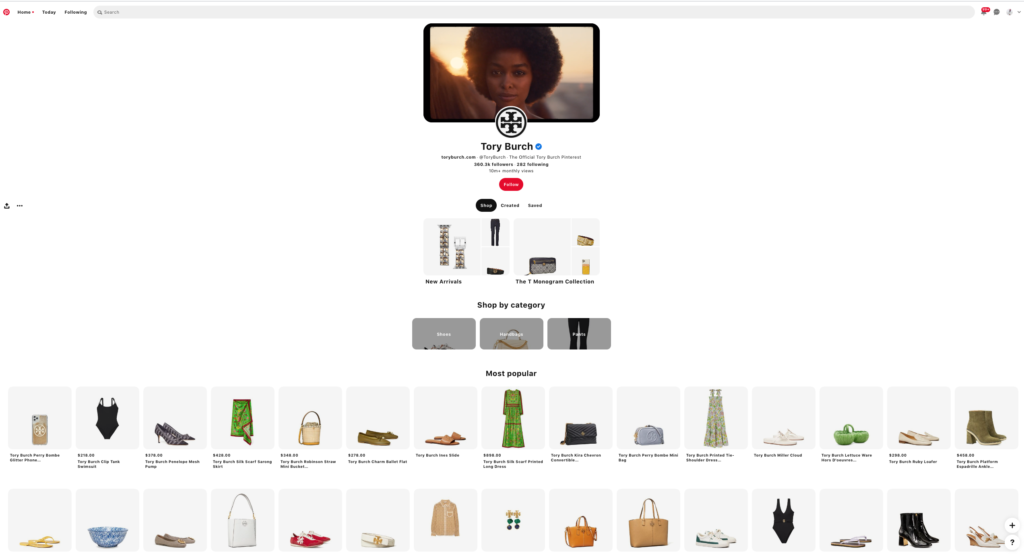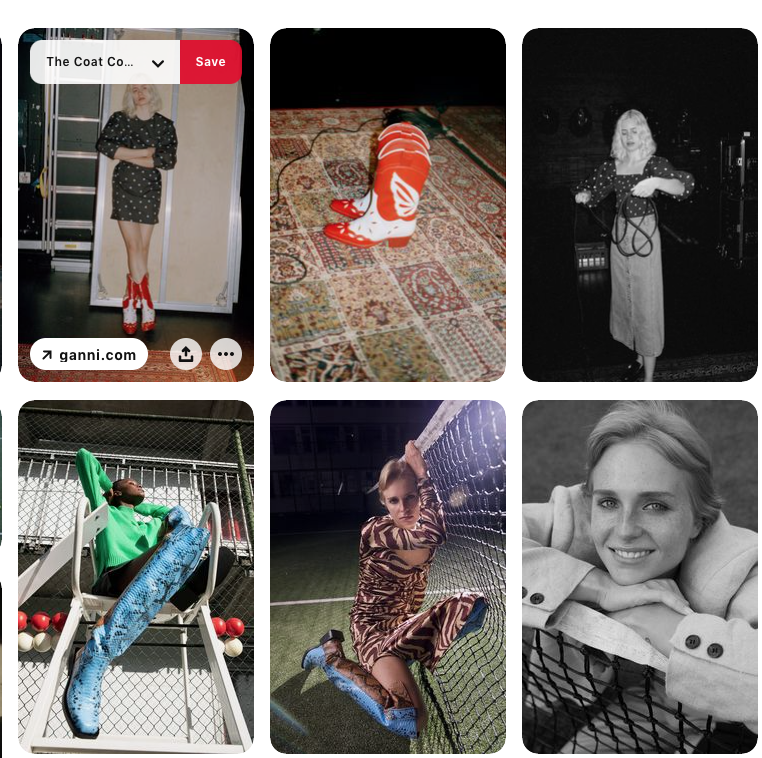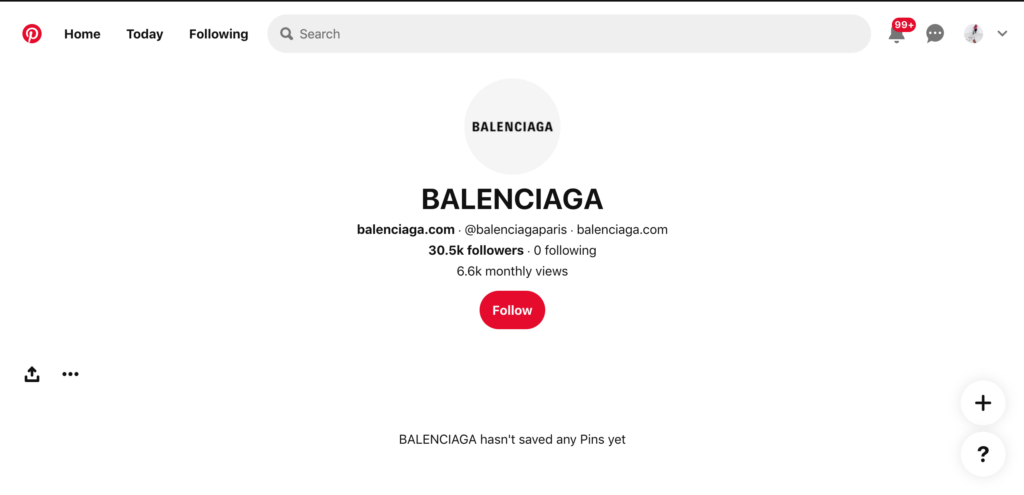How Luxury Fashion Brands Can Use Pinterest

Here at VERB, many of our luxury and premium clients have been asking about how they can use the social media platform, Pinterest, especially since we’ve seen the platform increase their ecommerce offering. For many of us we still only think of Pinterest as an image-inspiring, virtual moodboard, which is used to discover, save and curate picture/pin boards on the internet using images across the web, but there is much more to it than that; especially for marketers.
The growth of Pinterest as a marketing channel
Without much noise around it, Pinterest’s audience has seen signficant growth and they now have 445 million monthly active users.
Pinterest’s audience is experiencing significant growth due to a combination of factors. Firstly, Pinterest’s unique focus on visual discovery has attracted users who seek inspiration, ideas, and products. With its visually appealing interface and curated content, Pinterest provides a platform where users can easily find and save content that aligns with their interests and aspirations. This emphasis on personalized discovery has played a major role in attracting new users and keeping them engaged.
Secondly, Pinterest’s user base is expanding because of its versatility and broad appeal. Unlike other social media platforms that primarily focus on personal connections or entertainment, Pinterest’s content covers a wide range of categories, including home decor, fashion, cuisine, travel, and more. This broad scope of interests allows Pinterest to capture the attention of a diverse audience, spanning various demographics and interests. As a result, more users are turning to Pinterest as a go-to source for inspiration and as a tool to explore and discover new trends and products.
Pinterest for business
By taking advantage of Pinterest’s unique functionalities, businesses can effectively promote their products, drive website traffic, and increase sales.
What’s special and truly unique about Pinterest is that we have a decision-oriented, commercially minded audience. That means ads are additive on Pinterest. We’re putting brands in front of consumers who are actually open to discovering something new and are full of commercial intent. In fact, 84% of weekly Pinterest users come to the platform when they are considering products and services to buy but are undecided. 97% of the top searches on Pinterest are non-branded. Brands who use Pinterest well, understand that their customers on Pinterest travel from inspiration to action and back again on the platform and savvy retailers on Pinterest target content and advertising accordingly.

Just how effective is Pinterest for marketing?
Pinterest is an incredibly effective platform for marketing, offering a range of benefits for brands. With its focus on visual content, Pinterest provides a unique opportunity to showcase products and inspire potential customers, lets dive in more deeply.
Traffic driving e-commerce focus
Pinterest gives consumers purchasing power, as all products are just a few clicks away from being purchased. And we’ve seen some luxury fashion brands use the platform almost as a second website, hosting their products, with the idea to sell, sell, sell.
Many brands forget that Pinterest is a great traffic driving platform. The lifespan of one “pin” is much longer compared to that of a Facebook post as Pinterest’s functionality is to reshare, rather than like. Therefore the pin ‘lives longer’ as it is duplicated from one board to the next, giving the pin (aka the post and its link to your site/ product) a higher potential to reach a wide audience, and more opportunity for a sale.
Tory Burch is a great example of a brand taking this approach: sharing product shots, their Pinterest page displayed like a virtual shop window (with price tags on display too). Burberry has taken a similar approach, but mixes product shots with their campaign imagery.
A brand-building, curation
Pinterest has heavily invested in visual search which is why some luxury fashion brands are finding success on the platform. You can see the likes of Gucci and Ganni taking creative pinboards to the next level showcasing their brand story, their culture and their products through their inspirational boards. Some luxury brands are using Pinterest to curate inspiration boards to communicate the story and inspiration behind the fashion collection. They are not solely focussed on the sale but on brand awareness, story and creative direction instead. Above what Tory Burch is doing, this gives the user a more immersive brand experience on the platform.
Image search technology
In recent years Pinterest has developed their image identification technology; a feature which more people are using to find a product they’re looking for. A user uploads a picture of a product they like, or alternatively selects a part of an image they like, and the platform will serve you other pins that feature similar products. This works particularly well for fashion given its such a visual technology, but also as people tend to buy fashion based on its style, rather than practical qualities.
Preserving brand on the platform
Some luxury fashion brands have activated accounts but are yet to establish themselves with content on the platform. One reason for this is that they are creating an “official” brand page so that there isn’t someone who can create a counterfeit brand account. With high profile luxury brands, we see many brand fan accounts being created, sometimes with content that isn’t aligned to the brand’s values. By reserving their profile, they’re avoiding “fake” accounts which could be seen as the real brand account. Both Balenciaga and Hermes, have seemingly gone down this route, but I suspect they could be re-launching their Pinterest with a bang. With Balenciaga’s audience of 31k, there is the chance they’re keeping their Pinterest community in suspense before they share their innovative and forward-thinking aestheitc on a “board”.

Pinterest terminology
To get the most out of your Pinterest presence, it’s important to understand the terminology used on the platform. Here are a few key terms you need to know:
1. Pins: These are the images or videos that you share on Pinterest. Pins can be saved to your boards or discovered by other users through search or recommendation algorithms.
2. Boards: Boards are collections where you organize your pins. You can create boards based on different themes, topics, or categories, allowing you to categorize and display your content in a visually appealing way.
3. Pincodes: Pincodes are unique QR codes that you can create for your business. Users can scan these codes with their Pinterest app to discover your profile or a specific board, helping you drive engagement and awareness.
4. Tags: Tags are keywords or phrases that you can add to your pins to optimize their discoverability. When users search for a specific tag, relevant pins will show up in their search results.
Understanding these Pinterest terms is essential for maximizing your presence on the platform. By creating compelling pins, organizing them into boards, utilizing pincodes, and adding relevant tags, you can increase your visibility and engage with a wider audience.
Exploring how brands can maximize their presence on Pinterest
Pinterest presents great opportunities for brands to maximize their online presence and engage with their target audience. To achieve success on this visual platform, brands need to implement effective strategies and techniques.

How to create an effective Pinterest marketing strategy
Due to its ability to reach a large number of potential customers in a highly creative social media channel, it makes sense for businesses wanting to grow their online brand presence to set up a Pinterest board. Not only will this draw in your target audience with eye-catching ads that showcase new products, but it’s also an effective way to let the world see what your brand is all about.
Setting up a Pinterest business account
The first step to take in creating an effective DIY Pinterest marketing strategy is to set up a Pinterest business account. It gives you slightly different options than a personal account, allowing you to add your business name and logo to your profile.
Creating boards
With a Pinterest business account in place, you can then start to create Pinterest content that has a focus on your brand or products and really resonates with your audience. Group boards are a great place to share new plans and ideas. With a group board, you can invite others to contribute their thoughts on various topics and is a great way to engage with followers in real time.
One thing to keep in mind when creating product pins and boards is to always use high-quality images and visuals. Your design elements are the first thing that a potential customer is going to see when visiting your Pinterest profile or pins, so make sure your visual content looks good.
Increasing traffic
Through the use of Pinterest’s large user base, brands can showcase their products easily by using visually appealing Pinterest ads. Whether you choose to use influencers as a part of your Pinterest marketing campaign is completely optional, but partnering with the right influencer can be a great way to boost engagement on all your social media channels including Etsy, Canva, and of course, Pinterest.
Using various pins
There are various different pins to be used on Pinterest to enhance your social media marketing content including these very useful ones:
Idea pins are made up of a number of short video clips laid out in a story-like format. These pins help business owners better connect with their target audience via the power of video.
Rich pins are a great way for brands to increase their exposure online and enhance user experience simultaneously. These high-quality interactive pins provide more detailed information about a pinned post such as the price or availability of a product on a retailer’s website.
Buyable pins allow customers to purchase your products directly from the Pinterest platform, creating a quick and seamless shopping experience.
Advertising on Pinterest: Newer Ad formats
Pinterest has also developed its e-commerce offering, bringing the platform more in line with e-commerce capabilities of the likes of Facebook, Instagram and YouTube. Slightly late to the party, Pinterest now enables brands to target consumers to a similar sophistication as Facebook, with first party data, as well as their own third party data integration.
Pinterest have launched new ad formats for the platform. Where a sponsored “pin” was typically an image, there is now the ability to have “premiere video ads” as well as personalise ad messaging. It’s no surprise that with the rise of consumer shopping on social media 30% of consumers saying they’d make a purchase through Pinterest.
These new ad formats are also increasing the results seen with Pinterest users being 2.6x more likely to make a purchase after viewing brand video content on the platform. Matches Fashion are a brand to be utilising this feature. It seems there is more consumer intent than you may have thought on Pinterest. Conversions aside, brands should also be looking to Pinterest as a middle-of-the-funnel consumer touch-point; a way to make the consumer think.
Pintrest’s insights, trends tool
More recently, in December, Pinterest also relaunched their insights platform, which facilitates improved audience research, and broader outreach presenting a range of new opportunities for brands and businesses. This new update enables one to get an overview of broader usage trends and shifts – like the fact that usage among Gen Z and male Pinners has increased 40% over the past year.The rising interest in these demographics underlines the broadening use of Pins, and could pique the interest of even more brands who may look to consider the app for their planning. This is a growing tool which should not be overlooked.
Content creation strategies for Pinterest
When it comes to content creation strategies on Pinterest, it’s important to understand how to resonate with users and engage them effectively. One strategy is to create visually appealing and inspirational images that catch the attention of users scrolling through their feeds. These images should not only represent your brand but also evoke emotions and inspire users to take action.
Another effective strategy is to curate content from other brands and bloggers. By sharing high-quality content from industry influencers or related brands, you can establish your credibility and position yourself as a valuable source of information. This not only provides users with a variety of content but also expands your reach by connecting with the existing fanbase of these bloggers and brands.
Connecting with bloggers and Pinfluencers is a great way to amplify your reach on Pinterest. Collaborating with these influencers can help you create guest Boards featuring their content, which in turn exposes your brand to their loyal audience. This collaboration can attract new followers, drive traffic to your website, and ultimately grow your brand’s presence on Pinterest.
Posting frequent and unique content is key to maintaining an active presence on Pinterest. However, it’s important to avoid the Pinterest faux pas of pinning all new Pins at once. Instead, create a content calendar and schedule your Pins to be spread out over a period of time. This ensures that your content is consistently appearing in users’ feeds without overwhelming them with a flood of new Pins.
Pinterest marketing tools
Pinterest offers a variety of marketing tools that brands can utilize to reach their target audience and engage users on the platform. These tools can be grouped into three major categories: account management tools, image design and creation tools, and follower count and community growth tools.
Account management tools provide brands with the ability to optimize their presence on Pinterest. They include features such as Pinterest Analytics, which provides insights into audience demographics and performance metrics. Brands can also create a business profile and use rich pins to enhance their content with additional information, making it more engaging and valuable to users.
Image design and creation tools are essential for creating visually appealing content. Pinterest is primarily a visual platform, and branded pins need to stand out. Tools that enable brands to create eye-catching graphics and vertical images that are optimized for the Pinterest format should be your go to here. These tools often provide templates and design elements that make it easy to create professional-looking pins.
Follower count and community growth tools also help brands expand their reach and engage with their audience. They include features such as the Pinterest browser button, which allows users to save content from a brand’s website directly to their Pinterest boards. Brands can also collaborate with influencers or leverage Pinterest’s promoted pins feature to increase their visibility and attract a wider audience.
Optimize your strategy with Pinterest analytics tools
Once you have your Pinterest marketing strategy in place, the next step is to start tracking how well it’s performing. This can be done very easily through the use of Pinterest’s own analytics tools.
Tracking key metrics such as click-through rates, conversions, and sales is crucial for brands to measure the effectiveness of their Pinterest marketing efforts and understand the impact of Pinterest on driving website traffic and boosting online sales.
Click-through rates (CTR) indicate how successful a pin is in capturing user attention and encouraging them to visit the website for more information or make a purchase. By monitoring CTR, brands can determine which pins are resonating with their target audience and adjust their content accordingly. Pinterest Analytics provides detailed information on CTR for each pin, allowing brands to track and analyze the performance of their pins over time.
Conversions refer to the number of users who take a desired action on the brand’s website, such as signing up for a newsletter or making a purchase. By setting up conversion tracking through Pinterest Tag, brands can measure the effectiveness of their Pinterest campaigns in driving these actions. Pinterest Analytics provides insights into conversion events and the revenue generated from Pinterest traffic, enabling brands to analyze the impact of their Pinterest marketing on conversions and sales.
Sales data can also be measured and analyzed using Pinterest Analytics. By integrating their Pinterest account with their e-commerce platform, brands can track the revenue generated from Pinterest referrals and identify which pins or boards are driving the most sales. This data helps brands optimize their Pinterest strategy to focus on the pins and content that resonate best with their audience and drive the most revenue.
By tracking these key metrics, brands can gain valuable insights into the effectiveness of their Pinterest marketing efforts, make data-driven decisions to optimize their strategy, and ultimately drive more traffic and boost online sales from Pinterest.
With Pinterest Analytics, businesses can also gain valuable insight into how engaged customers are in your pins. Measurable metrics include
- Impressions – how many times your Pins appear in users’ feeds and Pinterest searches
- Close-ups – how many times a Pin is clicked/tapped
- Saves – how many times a user saves your Pin
- Save rate – the percentage of saves against the number of clicks
- Total audience – shows the total number of unique users your pin reached in a set period
Careful monitoring of these metrics, along with effective SEO (search engine optimization) practices will help increase not only your brand awareness across the board but will also help ensure you are delivering the right type of content to your followers.
Conclusion
With the opportunities on offer we’re seeing luxury fashion brands revisiting their Pinterest strategy to engage their community in new and innovative ways, either through a paid or organic presence.
With the increased sophistication in its analytical and insight tools plus improved advertising formats the platform offers luxury fashion brands more opportunity to reach their online audiences than ever before.
Get in touch with VERB to discuss your Pinterest or social media strategy.









